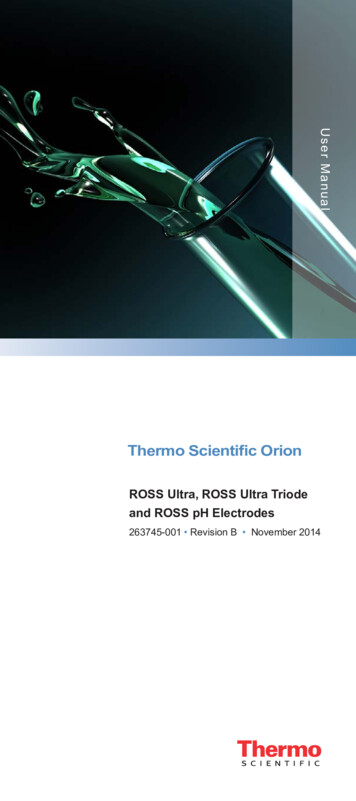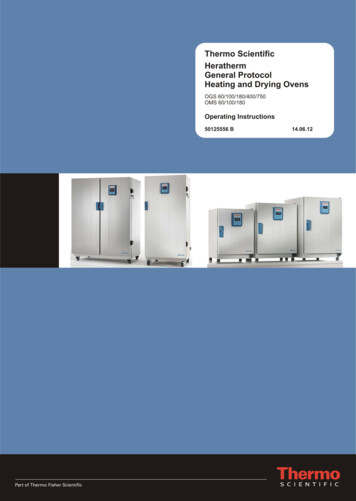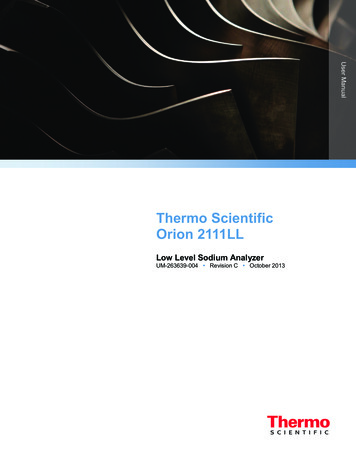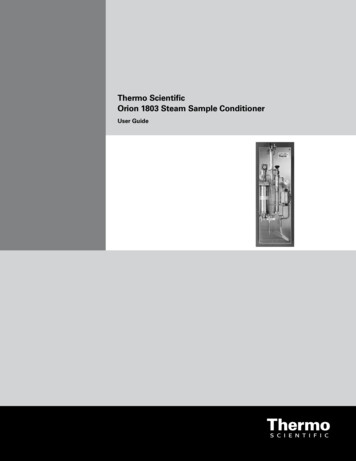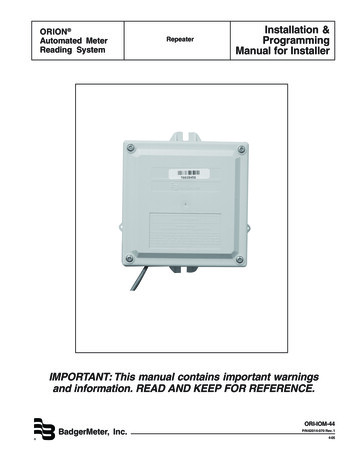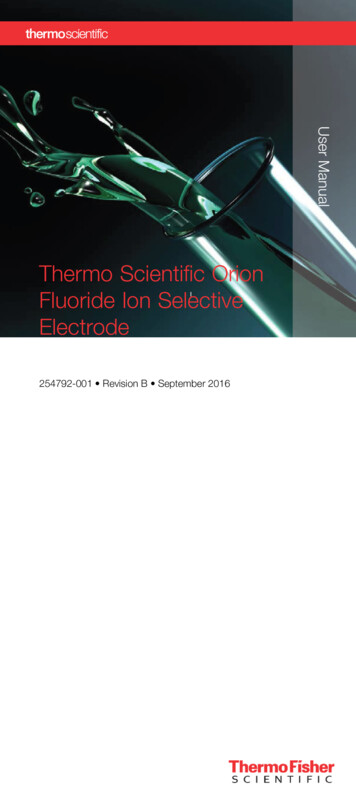
Transcription
User ManualThermo Scientific OrionFluoride Ion SelectiveElectrode254792-001 Revision B September 2016
Table of ContentsIntroduction . . . . . . . . . . . . . . . . . . . . . . . . . . . . . . 1Required Equipment . . . . . . . . . . . . . . . . . . . . . . . . 3Electrode Setup . . . . . . . . . . . . . . . . . . . . . . . . . . . 5Electrode Preparation . . . . . . . . . . . . . . . . . . . . . . . . . . . . . . . .Checking Electrode Operation (Slope) . . . . . . . . . . . . . . . . . . .Sample Requirements . . . . . . . . . . . . . . . . . . . . . . . . . . . . . . .Electrode Storage . . . . . . . . . . . . . . . . . . . . . . . . . . . . . . . . . . .5578Analytical Techniques . . . . . . . . . . . . . . . . . . . . . . 11Direct Calibration . . . . . . . . . . . . . . . . . . . . . . . . . . . . . . . . . .Low-Level Measurements . . . . . . . . . . . . . . . . . . . . . . . . . . . .Single Known Addition . . . . . . . . . . . . . . . . . . . . . . . . . . . . . .Titrations . . . . . . . . . . . . . . . . . . . . . . . . . . . . . . . . . . . . . . . .Fluoride in Alkaline Solutions . . . . . . . . . . . . . . . . . . . . . . . . . .1317192427Electrode Characteristics . . . . . . . . . . . . . . . . . . . 29Electrode Response . . . . . . . . . . . . . . . . . . . . . . . . . . . . . . . .Reproducibility . . . . . . . . . . . . . . . . . . . . . . . . . . . . . . . . . . . .Limits of Detection . . . . . . . . . . . . . . . . . . . . . . . . . . . . . . . . .Temperature Effects . . . . . . . . . . . . . . . . . . . . . . . . . . . . . . . .Complexation . . . . . . . . . . . . . . . . . . . . . . . . . . . . . . . . . . . . .Theory of Operation . . . . . . . . . . . . . . . . . . . . . . . . . . . . . . . .292929303132Troubleshooting . . . . . . . . . . . . . . . . . . . . . . . . . . 34Assistance . . . . . . . . . . . . . . . . . . . . . . . . . . . . . . . . . . . . . . . 35Warranty . . . . . . . . . . . . . . . . . . . . . . . . . . . . . . . . . . . . . . . . . 35Ordering Information . . . . . . . . . . . . . . . . . . . . . . . 37Specifications . . . . . . . . . . . . . . . . . . . . . . . . . . . . 38
IntroductionThis user guide contains information on the preparation, operationand maintenance for the fluoride ion selective electrode (ISE).General analytical procedures, electrode characteristics andelectrode theory are also included in this user guide. Fluorideelectrodes measure free fluoride ions in aqueous solutions quickly,simply, accurately and economically.The measurement of fluoride in drinking water and wastewaterusing an ion selective electrode is an EPA approved testprocedure. EPA-approved ISE test procedures for fluoride indrinking water and waste water are ASTM D1179(B) and StandardMethods 4500-F-C. EPA-approved ISE test procedures for fluoridein wastewater are ASTM D1179-93, 99 (B) and Standard Methods4500-F- C-97 (online) or 4500-F- B (18, 19, 20th editions).Approved test method lists are updated periodically. Check withyour regulatory agency for latest approve method revisions.Technical Support Chemists can be consulted for assistance andtroubleshooting advice. Within the United States and Canada,call 1.800.225.1480 or 978.232.6000 or email wai.techservbev@thermofisher.com. For countries outside of North America,contact your local authorized dealer. For the most current contactinformation, visit www.thermofisher.com/water. Fluoride ionplus Sure-Flow Combination ISEThe reference and sensing electrodes are built into one electrode,which decreases the amount of required solution and reduceswaste. The Sure-Flow reference junction prevents electrodeclogging and provides fast and stable readings. The fluorideionplus combination ISE is available with a waterproof BNCconnector, Cat. No. 9609BNWP. Electrodes with a waterproofBNC connector can be used on any ISE meter with a BNCconnection.Fluoride Half-Cell ISEThe fluoride half-cell electrode must be used with the singlejunction reference electrode, Cat. No. 900100. The fluoride halfcell is available with a BNC connector, Cat. No. 9409BN; and ascrew cap connector, Cat. No. 9409SC. Electrodes with a screwcap connector require a separate cable.Fluoride Ion Selective Electrode User Guide1
capspringcableO-ringinnerbodyfilling holefilling solutionchamberouter bodyreferenceelementinner coneSensing crystalFigure 1 9609BNWP Fluoride Combination Electrode2Fluoride Ion Selective Electrode User Guide
Required Equipment1. Thermo Scientific Orion ISE meter, such as the Orion StarA214 pH/ISE meter, Orion Dual Star two channel pH/ISEmeter or Orion Versa Star Pro pH/ISE meter. The fluorideelectrode can also be used on a variety of ISE meters witha BNC connection, please reference the meter manual foradditional information.2. Thermo Scientific Orion fluoride ion selective electrode. The9609BNWP fluoride electrode is a combination electrode. The9409BN and 9409SC fluoride half-cell electrodes require aseparate reference electrode,Cat. No. 900100.3. Magnetic stirrer or Orion stirrer probe, Cat. No. 096019.TheOrion stirrer probe can be used with Orion Star A214 pH/ISEmeter, Orion Dual Star two channel pH/ISE meter or OrionVersa Star Pro pH/ISE meter.4.Volumetric flasks, graduated cylinders and beakers. Plasticlabware is highly recommended for fluoride analysis.5. Distilled or deionized water.6. Fluoride electrode filling solution.Use Optimum Results A filling solution, Cat. No. 900061, forthe 9609BNWP fluoride electrodes.Use single junction reference electrode filling solution, Cat.No. 900001, for the reference electrode used with the9409BN and 9409SC fluoride electrodes.7. Fluoride calibration standards.Cat. No.Description9409060.1 M NaF, 475 mL bottle100 ppm F-, 475 mL bottle940907040908F4090510 ppm F- with TISAB II, 475 mL bottle5 ppm F- with TISAB II, 475 mL bottle0409032 ppm F- with TISAB II, 475 mL bottle1 ppm F- with TISAB II, 475 mL bottleF409040.5 ppm F- with TISAB II, 475 mL bottle040907Fluoride Ion Selective Electrode User Guide3
8. Total Ionic Strength Adjustment Buffer (TISAB), whichprovides a constant background ionic strength, decomplexesfluoride ions and adjusts the solution pH.9.Cat. No.Description940909TISAB II, 3.8 L bottle940999TISAB II, 4 x 3.8 L bottle940911TISAB III concentrate, 475 mL bottleUser-Prepared TISAB for special applications.Low-Level TISABFor use when measuring in samples containing less than 0.4 ppm(2 x 10-5 M) fluoride and no fluoride complexing agents such asiron or aluminum are present.To prepare low level TISAB: Place 500 mL of distilled water in a 1liter beaker. Add 57 mL of glacial acetic acid and 58 g of reagentgrade sodium chloride to the beaker. Place the beaker in a waterbath for cooling. Immerse a calibrated pH electrode into thesolution and slowly add 5 M NaOH until the pH is between 5.0and 5.5. Cool the solution to room temperature. Pour the solutioninto a 1 liter volumetric flask and dilute to the flask mark withdistilled water. All reagents must be as pure as possible to keepthe fluoride level low in the buffer.Use as directed for TISAB II; combine equal volumes of low levelTISAB and sample or standard before taking any measurements.TISAB IVTISAB IV will complex more than 100 ppm of iron or aluminumin the presence of 1 ppm fluoride. A measurement of 1 ppmfluoride will be in error by 5% in the presence of 200 ppm iron oraluminum. TISAB IV adjusts the pH to about 8.5, and should onlybe used for fluoride levels above 1 mg/L.To prepare TISAB IV: Place 500 mL of distilled water in a 1 litervolumetric flask. Add 84 mL of concentrated HCl (36 to 38 %),242 g TRIS (hydroxymethyl) aminomethane and 230 g sodiumtartrate (Na2C4H406-2H2O) to the flask. Stir to dissolve the solidsand cool the solution to room temperature. Dilute to the flask markwith distilled water.Use as directed for TISAB II; combine equal volumes of TISAB IVand sample or standard before measurements.4Fluoride Ion Selective Electrode User Guide
Electrode SetupElectrode Preparation9409BN and 9409SC Fluoride Half-Cell Electrode– Remove theprotective shipping cap from the sensing element and save thecap for storage.900100 Single Junction Reference Electrode– Prepare thereference electrode according to the reference electrode userguide. Fill the reference electrode with single junction referencefilling solution, Cat. No. 900001.9609BNWP Fluoride Combination Electrode– Remove theprotective shipping cap from the sensing element and save thecap for storage. Fill the electrode with Optimum Results A fillingsolution, Cat. No. 900061.Note: Optimum Results A fifilling solution minimizes junctionpotential issues and flfluoride contamination in the sample. The useof any other fifilling solution will void the electrode warranty.Electrode Filling Instructions1. Lift the flip spout on the filling solution bottle to a verticalposition.2. Insert the spout into the filling hole on the outer body of theelectrode and add a small amount of filling solution to thereference chamber. Invert the electrode to moisten the topO-ring and then return the electrode to the upright position.3. Hold the electrode body with one hand and use your thumbto push down on the electrode cap to allow a few drops offilling solution to drain out of the electrode.4. Release the electrode cap. If the sleeve does not return to itsoriginal position, check if the O-ring is moist and repeat steps2-4 until the sleeve returns to the original position.5. Add filling solution to the electrode up to the filling hole.Note: Add filling solution each day before using the electrode.The filling solution level should be at least one inch above the levelof sample in the beaker to ensure a proper flow rate. The fill holeshould always be open when taking measurements.Checking Electrode Operation (Slope)These are general instructions that can be used with most metersto check the electrode operation. Refer to the meter user guide formore specific information.Fluoride Ion Selective Electrode User Guide5
This procedure measures electrode slope. Slope is defined asthe change in millivolts observed with every tenfold change inconcentration. Obtaining the slope value provides the best meansfor checking electrode operation.1. If the electrode has been stored dry, prepare the electrode asdescribed in the “Electrode Preparation” section.2. Connect the electrode to the meter. Set the meter to the mVmode.3. Place 50 mL of distilled water and 50 mL of TISAB II (Lowlevel TISAB or TISAB IV) into a 150 mL beaker. Stir thesolution thoroughly.If using TISAB III, place 90 mL of distilled water and10 mL of TISAB III into a 150 mL beaker. Stir the solutionthoroughly.4. Rinse the electrode with distilled water and place theelectrode into the solution prepared in step 3.5. Select either a 0.1 M sodium fluoride or 100 ppm fluoridestandard. Pipette 1 mL of the standard into the beaker andstir thoroughly. When a stable reading is displayed, record theelectrode potential in millivolts.6. Pipette 10 mL of the same standard into the same beakerand stir thoroughly. When a stable reading is displayed,record the electrode potential in millivolts.7.There should be a 54 to 60 mV difference between the twomillivolt readings when the solution temperature is between20 to 25 C. If the millivolt potential is not within this range,refer to the “Troubleshooting” section.Measurement UnitsFluoride concentration can be measured in moles per liter (M),parts per million (ppm) or any convenient concentration unit.Table 1 Concentration Unit Conversion FactorsMoles/Liter e Ion Selective Electrode User Guide
Sample RequirementsThe epoxy body of the fluoride electrode is resistant to damageby inorganic solutions. The electrode may be used intermittentlyin solutions that contain methanol or acetone. Contact TechnicalSupport for information on using the electrode for specificapplications.Samples and standards should be at the same temperature.The solution temperature must be less than 100 C.In all analytical procedures, TISAB must be added to all samplesand standards before measurements are taken.Measuring Hints Add 50 mL of TISAB II (Low-level TISAB or TISAB IV) to every50 mL of standard or sample. Add 10 mL of TISAB III to every90 mL standard or sample. Once TISAB II (Low- level TISABor TISAB IV) or TISAB III is selected, it should be added toall samples and standards so the dilution ratio of TISAB tosolution remains the same. Stir all standards and samples at a uniform rate. Always use fresh standards for calibration. Always rinse the electrode with deionized water betweenmeasurements and shake the electrode to remove thewater and prevent sample carryover. Do not wipe or rub theelectrode sensing element. Allow all standards and samples to come to the sametemperature for precise measurements. Place a piece of insulating material, such as Styrofoam orcardboard, between the magnetic stirrer and beaker toprevent measurement errors from the transfer of heat to thesample. Verify the electrode calibration every two hours by placing theelectrode in a fresh aliquot of the least concentrated standardused for calibration. If using more than 2 standards, use amid-level standard. If the value has changed by more than2%, recalibrate the electrode. After immersing the electrode in a solution, check theelectrode sensing surface for air bubbles and remove airbubbles by reimmersing the electrode in the solution. For high ionic strength samples (e.g.,more concentrated than0.1 M), prepare standards with a background compositionsimilar to the sample or use manual known additionprocedure or a Dual Star meter.Fluoride Ion Selective Electrode User Guide7
For acidic samples (pH 5) or alkaline samples (pH 9.5),use the Fluoride in Acid Solutions or Fluoride in AlkalineSolutions Procedures found in this User Guide. Remove the filling hole cover during measurements to ensurea uniform flow of filling solution. If the electrode is used in dirty or viscous samples or theelectrode response becomes sluggish, empty the electrodecompletely, hold the junction open and flush the junctionwith deionized water. Empty any water from the electrodeand refill it with fresh filling solution. Press down on theelectrode cap to let a few drops of the filling solution flow outof the electrode and then replenish any lost solution. If thisprocedure does not resolve the issue, refer to the “ElectrodeMaintenance” section for further cleaning.Electrode Storage9409BN and 9409SC Fluoride Half-Cell ElectrodeThe fluoride half-cell electrodes should be rinsed thoroughly withdistilled water and stored dry in the air at all times. When storingthe electrode for long periods of time, cover the sensing elementwith the protective shipping cap.900100 Single Junction Reference ElectrodeThe single junction reference electrode may be stored in the singlejunction electrode filling solution, Cat. No. 900001, betweensample measurements and up to one week. The filling solutioninside the electrode should not be allowed to evaporate, ascrystallization will result. For storage longer than one week, drainthe reference electrode, flush the inside with distilled water andtore the electrode dry.9609BNWP Fluoride Combination ElectrodeFor storage between measurements and up to one week, storethe electrode in electrode filling solution, Cat. No. 900061, withfluoride added to 1 – 10 ppm level. The fluoride concentrationof the storage solution should be close to least concentratedfluoride calibration standard. Do not add TISAB to the storagesolution. The filling solution should not be allowed to evaporate,as crystallization will result. If filling solution is unavailable, store in 0.7 M potassium chloride with 1 – 10 ppm fluoride added.For storage longer than one week, drain the electrode. Flushthe chamber with distilled water. Disassemble the electrode asdescribed in the electrode maintenance section. Rinse the innersleeve with distilled water and blot dry with a Kimwipe. Do nottouch the reference element other than to blot dry. Let air dry andthen reassemble for storage. Use the protective shipping cap tocover the sensing element.8Fluoride Ion Selective Electrode User Guide
Electrode MaintenancePolishing the Sensing Surface of the Fluoride CombinationElectrodes and Fluoride Half-Cell ElectrodesThe sensing surface of the fluoride electrode might needrestoration over time as deposits coat the sensing surface. Thesensing crystal can be restored using the following procedure.Toothpaste that contains fluoride will be needed for this procedure.1. Dispense a small amount of toothpaste on a kimwipe. Add afew drops of deionized water. A soft toothbrush can also beused in placed of a kimwipe.2. Rub the toothpaste on the sensing element on the bottom ofthe electrode in a circular motion for around one minute.3.Rinse the electrode thoroughly with DI water, flush theelectrode fill solution out (if using a combination fluorideelectrode) by pressing on the cap of the electrode) then refillwith fresh fill solution.4.Soak the electrode in 100 ppm fluoride standard for 2 hours.Flushing the 9609BNWP and 900100 Single JunctionReference ElectrodeIf the area between the electrode sleeve and inner cone becomesclogged with sample or precipitate, flush the area with fillingsolution or distilled water.1. Hold the electrode body with one hand and use your thumbto push down on the electrode cap to drain the chamber.Push down on the cap until all the filling solution is drainedfrom the chamber.2. Fill the electrode with distilled water and then push down onthe cap until all the water is drained from the chamber.3. Fill the electrode with fresh filling solution up to the fill hole.Push down on the cap to allow a few drops of filling solutionto drain out of the electrode and then refill any lost fillingsolution.Disassembling the Fluoride Combination Electrodes andSingle Junction Reference ElectrodeNote: Disassembly is usually not required and should not bedone unless a thorough cleaning is required.1. Tip the electrode so the filling solution moistens the O-ring onthe electrode body. Hold the electrode body with one handand use your thumb to push down on the electrode cap todrain the chamber.Fluoride Ion Selective Electrode User Guide9
2. Unscrew the cap counter clock-wise and then slide the capand the spring up the cable.3. Hold the outer sleeve with one hand and firmly push downon the threaded portion with the thumb and forefinger toseparate the inner body from the sleeve.4. Grasp the cone with a clean, lint-free tissue and withdrawthe body from the sleeve using a gentle twisting motion.Do not touch the reference electrode element (coiled wirein combination electrode, pellet in single junction reference)above the cone, it will damage to the reference element.Rinse the outside of the electrode body and the entire sleevewith distilled water. Blot dry with a Kimwipe and allow to airdry if needed.Reassembling the Fluoride Combination Electrodes andSingle Junction Reference Electrode1. Moisten the O-ring on the electrode body with a drop of fillingsolution. Insert the screw-thread end of the electrode bodyinto the tapered, ground end of the sleeve.2. Push the body into the sleeve using a gentle twisting motionuntil the bottom surface of the inner cone is flush with thetapered end of the sleeve.3. Place the spring onto the electrode body and screw on thecap. Refill the electrode with filling solution.10Fluoride Ion Selective Electrode User Guide
Analytical TechniquesA variety of analytical techniques are available to the analyst. Thefollowing is a description of these techniques.Direct Calibration is a simple procedure for measuring a largenumber of samples. Only one meter reading is required for eachsample. Calibration is performed using a series of standards. Theconcentration of the samples is determined by comparison to thestandards. TISAB is added to all solutions to ensure that samplesand standards have similar ionic strength.Incremental Techniques provide a useful method for measuringsamples, since calibration is not required. As in direct calibration,any convenient concentration unit can be used. The differentincremental techniques are described below. They can be used tomeasure the total concentration of a specific ion in the presence ofa large (50-100 times) excess of complexing agents. Known Addition is useful for measuring dilute samples,checking the results of direct calibration (when no complexingagents are present), or measuring the total concentration ofan ion in the presence of an excess complexing agent. Theelectrode is immersed in the sample solution and an aliquotof a standard solution containing the measured species isadded to the sample when performing single known addition.From the change in potential before and after the addition, theoriginal sample concentration is determined. Double knownaddition is recommended for complex sample matrices. Known Subtraction is useful as a quick version of a titration,or for measuring species for which stable standards do notexist. It is necessary to know the stoichiometric ratio betweenstandard and sample. For known subtraction, an electrodesensing the sample species is used. Stable standards of aspecies reacting completely with the sample in a reaction ofknown stoichiometry are necessary. Analate Addition is often used to measure soluble solidsamples, viscous samples, small or very concentratedsamples, to diminish the effects of complex sample matrices,or to diminish the effects of varying sample temperatures.This method is not suitable for dilute or low concentrationsamples. Total concentration is measured even in thepresence of complexing agents. The electrode is immersedin a standard solution containing the ion to be measuredand an aliquot of the sample is added to the standard. Theoriginal sample concentration is determined on the change inpotential before and after the addition. Analate Subtraction is used in the measurement of ionsfor which no ion-selective electrode exists. The electrode isimmersed in a reagent solution that contains a species thatthe electrode senses, and that reacts with the sample. It isuseful when sample size is small, or samples for which aFluoride Ion Selective Electrode User Guide11
stable standard is difficult to prepare, and for viscous or veryconcentrated samples. The method is not suited for verydilute samples. It is also necessary to know the stoichiometricratio between standard and sample.Titrations are quantitative analytical techniques for measuringthe concentration of a species by incremental addition of areagent (titrant) that reacts with the sample species. Sensingelectrodes can be used for determination of the titrationend point. Ion selective electrodes are useful as end pointdetectors, because they are unaffected by sample color orturbidity. Titrations are approximately 10 times more precisethan direct calibration, but are more time-consuming. Typical Calibration CurveIn the direct calibration procedure, a calibration curve isconstructed either in the meter memory or in an electronicspreadsheet and graphing the log of the fluoride concentrationagainst the millivolt value readings. Electrode potentials ofstandard solutions are measured and plotted on the linear axisagainst their concentrations on the log axis. In the linear regionsof the curves, only two standards are needed to determinea calibration curve. In non-linear regions, more points mustbe taken. These direct calibration procedures are given forconcentrations in the region of linear electrode response. Lowlevel measurement procedures are given in the next section formeasurements in the non-linear region.-60.-40electrodepotential(mV)-20010-fold change2040-54 to -60 mV6080100120140160180ppm fluoride as F0.1101-51010-410100-3101000-2-110molarityFigure 2 Typical Calibration Curve12Fluoride Ion Selective Electrode User Guide
Direct CalibrationSetup1. Prepare the electrode as described in the “ElectrodePreparation” section. If using the 9409BN or 9409SC halfcell fluoride electrode with the 900100 reference electrode,fill the reference electrode with Cat. No. 900001. If using the9609BNWP combination fluoride electrode, fill the electrodewith Cat. No. 900061.2. Connect the electrode to the meter.3. Prepare at least two standards that bracket the expectedsample range and differ in concentration by a factor of ten.Standards can be prepared in any concentration unit to suitthe particular analysis requirement. All standards should be atthe same temperature as the samples. Single Known AdditionFor details on temperature effects on electrode performance,refer to the “Temperature Effects” section.Orion Fluoride Standards with TISAB IIThe following Orion fluoride standard solutions do not require theaddition of TISAB II because TISAB II has already been added in aratio of 1:1 to the standard solution.- 10 ppm fluoride with TISAB II standard, Cat. No. 040908- 5 ppm fluoride with TISAB II standard, Cat. No. F40905- 2 ppm fluoride with TISAB II standard, Cat. No. 040907- 1 ppm fluoride with TISAB II standard, Cat. No. 040906- 0.5 ppm fluoride with TISAB II standard, Cat. No. F40904For sample measurement after calibration, add 50 mL of TISAB IIto every 50 mL of sample to keep the dilution ration of TISAB II tosolution consistent for the standards and samples.User-Prepared Standards by Serial DilutionsSerial dilution is the best method for the preparation of standards.Serial dilution means that an initial standard is diluted, usingvolumetric glassware, to prepare a second standard solution. Thesecond standard is similarly diluted to prepare a third standard,and so on, until the desired range of standards has beenprepared.1.-2To prepare a 10 M NaF standard (190 ppm fluoride)–Pipette 10 mL of the 0.1 M NaF standard into a 100 mLvolumetric flask. Dilute to the mark with deionized water andmix well.Fluoride Ion Selective Electrode User Guide13
-32.To prepare a 10 M NaF standard (19 ppm fluoride)–-2Pipette 10 mL of the 10 M NaF standard into a 100 mLvolumetric flask. Dilute to the mark with deionized water andmix well.3.To prepare a 10-4 M NaF standard (1.9 ppm fluoride)–Pipette 10 mL of the 10-3 M NaF standard into a 100 mLvolumetric flask. Dilute to the mark with deionized water andmix well.To prepare standards with a different concentration use thefollowing formula:C1 * V1 C2 * V2where: C1 concentration of original standardV1 volume of original standardC2 concentration of standard after dilutionV2 volume of standard after dilutionFor example, to prepare 100 mL of a 1 ppm fluoride standard froma 100 ppm fluoride standard:C1 100 ppm fluorideV1 unknownC2 1 ppm fluorideV2 100 mL100 ppm * V1 1 ppm * 100 mLV1 (1 ppm * 100 mL) / 100 ppm 1 mLTo make the 1 ppm fluoride standard, pipette 1 mL of the100 ppm fluoride standard into a 100 mL volumetric flask.Dilute to the mark with deionized water and mix well.Direct Calibration Using a Meter with an ISE ModeNote: See the meter user guide for more specific information.Sample measurement can be performed after a two-pointdirect calibration. It is recommended that the two standardconcentrations used in the calibration bracket the sampleconcentration. It is also recommended that the two standardconcentrations be 10 fold apart for general applications.14Fluoride Ion Selective Electrode User Guide
Using Orion Standard Solutions Containing TISAB II:1. Pour an adequate amount (e.g.100 mL) of the lessconcentrated standard (e.g., 0.5 ppm fluoride with TISAB IIstandard, or 1 ppm fluoride with TISAB II standard) into a 150mL beaker.2. Rinse the electrode with deionized water, blot dry and placeinto the beaker containing the less concentrated standard.Stir the solution thoroughly. Wait for a stable reading andthen adjust the meter to display the value of the standard, asdescribed in the meter user guide.3.Pour an adequate amount (e.g.100 mL) of the moreconcentrated standard (e.g., 5 ppm fluoride with TISABII standard, or 10 ppm fluoride with TISAB II standard,respectively) into a 150 mL beaker.4.Rinse the electrode with deionized water, blot dry and placeinto the beaker with the more concentrated standard. Stir thesolution thoroughly. Wait for a stable reading and then adjustthe meter to display the value of the second standard, asdescribed in the meter user guide.5.Record the resulting slope value. The slope should bebetween -54 to -60 mV when the standards are between20-25 C.6.Measure 50 mL of the sample and 50 mL of TISAB II andpour into a clean 150 mL beaker. Stir the solution thoroughly.7. Rinse the electrode with deionized water, blot dry and placeinto the sample. The concentration of the sample will bedisplayed on the meter.Using User-Prepared Fluoride Standard Solutions withoutTISAB:1.Measure 50 mL of the less concentrated standard and 50 mLof TISAB II and pour into a 150 mL beaker. Stir the solutionthoroughly.2.Rinse the electrode with deionized water, blot dry and placeinto the beaker with the less concentrated standard. Waitfor a stable reading and then adjust the meter to display thevalue of the standard, as described in the meter user guide.3.Measure 50 mL of the more
940909 TISAB II, 3 .8 L bottle 940999 TISAB II, 4 x 3 .8 L bottle 940911 TISAB III concentrate, 475 mL bottle 9 . User-Prepared TISAB for special applications . Low-Level TISAB For use when measuring in samples containing less than 0 .4 ppm (2 x 10-5 M) fluoride and no fluoride complexing agents such as iron or aluminum are present .
